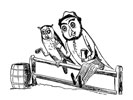




Back to the End Of The Georgians calendar



Early in this section we looked at how art and poetry had become more popular. This also applied to books and novels and there were many great writers penning novels. It was in 1839 that Charles Dickens, perhaps England's best known novelist, finished publishing his story, Oliver Twist. It was published in bits each month and then made into a book. This was the way many of his great works were done. I'm sure many of you have heard the story of Oliver Twist even if only from musicals that have been adapted from it.
In the same way that the poets we talked about earlier highlighted the poverty in the country, Dickens did the same. In Oliver Twist, he brought to the attention of his, often, wealthy, readers, how life was lived in the poor houses and slums of London. Other novels, such as Great Expectations, also brought real life to a wider audience. Many poor people would pay ½p each week to have each episode read to them.
Dickens was not the only author from these times. Jane Austen, who wrote Sense and Sensibility, Pride and Prejudice and Emma among other titles, lived a little before Dickens. The Bronte sisters, Charlotte, Emily and Anne all wrote novels. Emily's only novel was Wuthering Heights, Anne was best known for Tenant of Wildfell Hall, while Charlotte is most famous for Jane Eyre.
 We should also include Mary Shelley, wife of one of our earlier romantic poets Percy Byshe Shelley. Mary ran away with Shelley in 1816 and spent time travelling through Europe. During this time she had the idea for a novel about a scientist who creates a grotesque creature in a scientific experiment. The novel was published in 1818, 3 years after she first had that idea, and was one of the very first science fiction novels. It was called Frankenstein, the name of the scientist in the book. And Mary Shelley was the Mary whose mother, Mary Wollstoenbcraft, had died after giving birth to her in our last century. Check it out, 1792.
We should also include Mary Shelley, wife of one of our earlier romantic poets Percy Byshe Shelley. Mary ran away with Shelley in 1816 and spent time travelling through Europe. During this time she had the idea for a novel about a scientist who creates a grotesque creature in a scientific experiment. The novel was published in 1818, 3 years after she first had that idea, and was one of the very first science fiction novels. It was called Frankenstein, the name of the scientist in the book. And Mary Shelley was the Mary whose mother, Mary Wollstoenbcraft, had died after giving birth to her in our last century. Check it out, 1792.
It wasn't just novelist who became famous. Way back in 1747, that is way back, a man called Samuel Johnson had been given 1,500 guineas, about £1,575, to write a dictionary. That's about a quarter of a million pounds today. It took him seven years, he said it would take three, and was published on 4 April 1755. He did it all himself and it was seen as the most important dictionary of the English language until the Oxford English dictionary was finally complete in 1918. Johnson's work didn't really have a happy ending, especially if you were an animal. The last word was zootomy, so go and look it up.
Meanwhile, a man called Edward Lear published A Book of Nonsense in 1846. This was a set of limericks and helped to make this form of a poem popular. A limerick is a five line poem with the third and fourth lines slightly shorter than the others. Lines 1,2 and 5 generally rhyme, while 3 and 4 also rhyme. Edward Lear also drew little illustrations for each limerick. Owlbut likes this one:-
 There was an Old Man with a owl,
There was an Old Man with a owl,
Who continued to bother and howl
He sat on a rail
And imbibed bitter ale,
Which refreshed that Old Man and his owl.
This has given Owlbut an idea for a competition.
Let's finish this bit with a list of Charles Dickens' most famous novels.
The Pickwick Papers
Oliver Twist
Nicholas Nickleby
The Old Curiosity Shop
A Christmas Carol
David Copperfield
Little Dorrit
A Tale of Two Cities
Great Expectations
Forward to 1840AD

